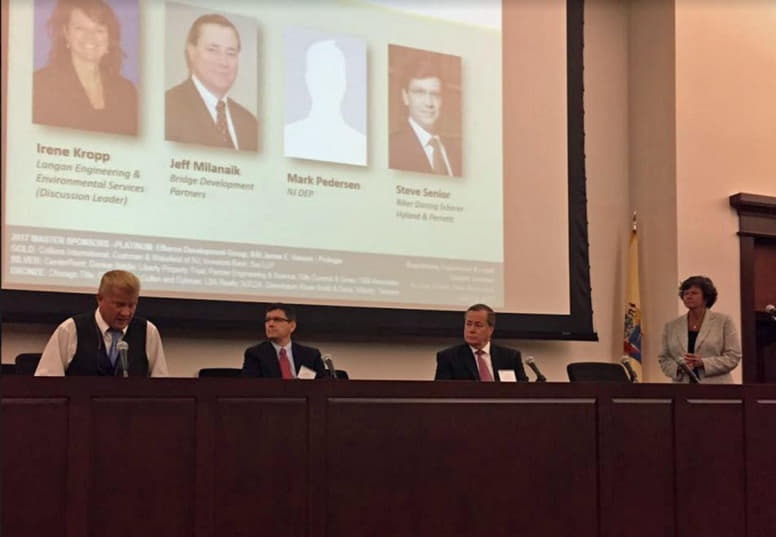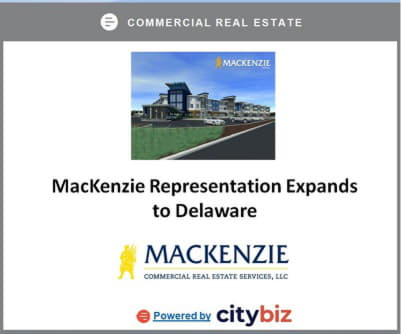Recent legal decisions and pending legislation that are reshaping the development process in New Jersey were among the topics discussed during NAIOP New Jersey’s annual Regulatory, Legislative & Legal Update Seminar, held at the New Jersey Law Center in New Brunswick, N.J.

(L-R): Mark Pedersen (NJ DEP), Steve Senior (Riker Danzig Scherer Hyland & Perretti), Jeff Milanaik (Bridge Development Group), Irene Kropp (Langan Engineering & Environmental Services)
Michael McGuinness, CEO of the commercial real estate development association, led the opening discussion which focused on the impact of key legislative and legal issues on commercial real estate development in the Garden State.
Meryl Gonchar, Co-Chair of the Sills, Cummis & Gross Land Use Practice Group, discussed recent developments in the Dunbar Case, which involves the processing of applications for development.“The time of application law states that upon filing an application for development, it locks the zoning in place,” Gonchar explained. “In order to gain protection of the provision, you did not have to file a complete application.”
However, as a result of a challenge involving the Borough of Franklin Lakes, a judge overturned a previous ruling regarding the definition of completeness, stating that all required documents must be submitted at the time of the application. “For developers, this issue is critically important to processing an application,” said McGuinness. “The applicant is appealing and NAIOP NJ filed a motion for permission to participate.” (This motion was granted on July 18).
Anthony Pizzutillo of Pizzutillo Public Affairs LLC addressed the current status of liquorlicense reform, specifically the legislation that has been proposed by Assemblyman John Burzichelli (D-Gloucester).
“This legislation is designed to create opportunity for small restaurants, not chains, as well as to protect existing liquor license holders,” said Pizzutillo. “The lawproposes the issuance of liquor permits to establishments where patrons must be seated at a table for service. It does not cover standing bars or places where liquor can be purchased and carried out.” The permits must be renewed annually and a compensation scheme for existing license holders is included in the proposal.
Pizzutillo noted that although the legislation remains in committee, support has been growing among local leaders and an analysis has been completed showing the net financial benefit of the proposed expansion to municipalities. “We are optimistic that with growing momentum and new leadership in place, we can move this forward.”
Asked about the status of pending legislation regarding PILOTs, Pizzutillo said that “there are plenty of misperceptions about these programs, which are attracting a lot of attention from lawmakers.” He noted that an assortment of legislation has been introduced to regulate school funding and NAIOP has supported a proposal for residential PILOTs to establish a fixed five percent to be shared by towns.
“These incentives are a campaign issue for both gubernatorial candidates, and we plan to educate the Murphy and Guadagno teams about the critical importance of these programs to redevelopment in our state. The more local administrators we have supporting this issue, the better.”
Site Remediation Update
The first of two panel discussions examined key issues related to the Site Remediation Reform Act (SRRA), which has changed the process used to conduct environmental investigations and cleanups in New Jersey. A panel led by Irene Kropp, senior environmental consultant at Langan Engineering & Environmental Services, focused on the success of the LSRP program (Licensed Site Remediation Professional) and a preview of proposed changes to the act, known as SRRA 2.0.
“Since the advent of SRRA, the number of contaminated sites in the state has dropped from over 20,000 to 14,000,” said Mark Pedersen, assistant commissioner for NJ DEP’s Site Remediation and Waste Management Program. “In 2015 and 2016, we closed fewer sites than we brought into the program. However, this trend has been reversed in the first six months of this year, and by the end of 2017 we hope to be below 14,000 sites. It’s exciting to see these numbers come down.”
Pedersen credits this progress to the success of the LSRP program. “We are getting out of the way and allowing LSRPs to do what they do best,” he said. However, the DEP continues to work to reduce the amount of time it takes to process remediation action permits. “We were told we were taking too long and challenged the team to work faster. The department’s processing time is now 120 days and we’re working to lower it.”
Panelists exchanged views on a number of changes that are being considered for the revised “2.0” version of SRRA. One hotly-debated issue was who is responsible for reporting contamination on a site. Pedersen is proposing a change that would obligatethe seller, not the LSRP, to report it and to be responsible for remediating the site.Steve Senior, a partner in Riker Danzig Scherer Hyland & Perretti’s Environmental Group, disagreed.
“In my view, the current site remediation format strikes the proper balance. If LSRPs are doing due diligence for a potential purchaser, they are required to report any immediate environmental concern. However, anyone who finds contamination, including a party who is responsible for the site, should report it as well. We don’t need to rewrite the act, we just need to interpret it properly.”
Jeff Milanaik, principal/market officer with Bridge Development Group, noted, “Developers get stuck in the middle of the debate of interpretation of the laws. As a buyer, what we need is certainty. We want to have a clear understanding of the ground rules, identify things that need to be addressed and know when we can move forward.”
Improving Water Quality and Resource Management
Jay Rhatican, assistant general counsel for Hartz Mountain Industries, facilitated the second panel discussion, which addressed water resource issues including infrastructure, stormwater management and quality.
Michele Putnam, director of the Division of Water Quality at the NJ DEP, discussed New Jersey’s aging infrastructure, particularly in urban areas. “When you are considering a site for redevelopment, you need to provide additional resources to upgrade older pipes, pumps and treatment systems, many of which are over 100 years old.”
Putnam’s remarks focused on the state’s storm water systems, in particular the DEP’s efforts to upgrade the more than 200 Combined Sewer Overlfows (CSO) that carry both water and sewage in municipalities throughout the state. In addition to issuing new permits to tighten regulations to reduce pollution and improve infrastructure, Putnam emphasized that developers need to incorporate Green Infrastructure (GI) when they are developing or redeveloping urban areas.
“Consider ways of managing storm water overflow on your sites that more closely mimic the natural cycle,” Putnam advised. “The DEP is working closely with LSRPs to provide guidance on strategies for incorporating GI on remediation sites, and offering attractive financial incentives to communities to establish these systems.”
Putnam said that the department works with the New Jersey Environmental Infrastructure Trust (EIT) to fund water infrastructure projects in local communities across the state. Private companies can partner with a government entity to finance infrastructure improvements, particularly in high-priority CSO areas.
Tony DiLodovico of Bowman Consulting, whose firm assists municipalities in solving storm water and sewage management issues, said, “We are encouraged by the DEP’s progress in coordinating its efforts and putting together financing programs to support much-needed improvements.”
Andrea Adebowale with City of Newark’s Department of Water & Sewer Utilities described the city’s efforts to overhaul its storm water infrastructure. “We began working with the Passaic County Sewage Commission in 2015, and we are now in the process of deciding what the design will be for all of our facilities,” said Adebowale. “It is a very long process that involves the cooperation of everyone from municipalities to developers to property owners.”
She noted that the process has provided “a rare opportunity to get input from developers upfront. We meet regularly to talk about issues and how we can work together to make their jobs easier. We want to encourage the development that is critical to ensuring that Newark becomes one of the premier cities in the country.”









